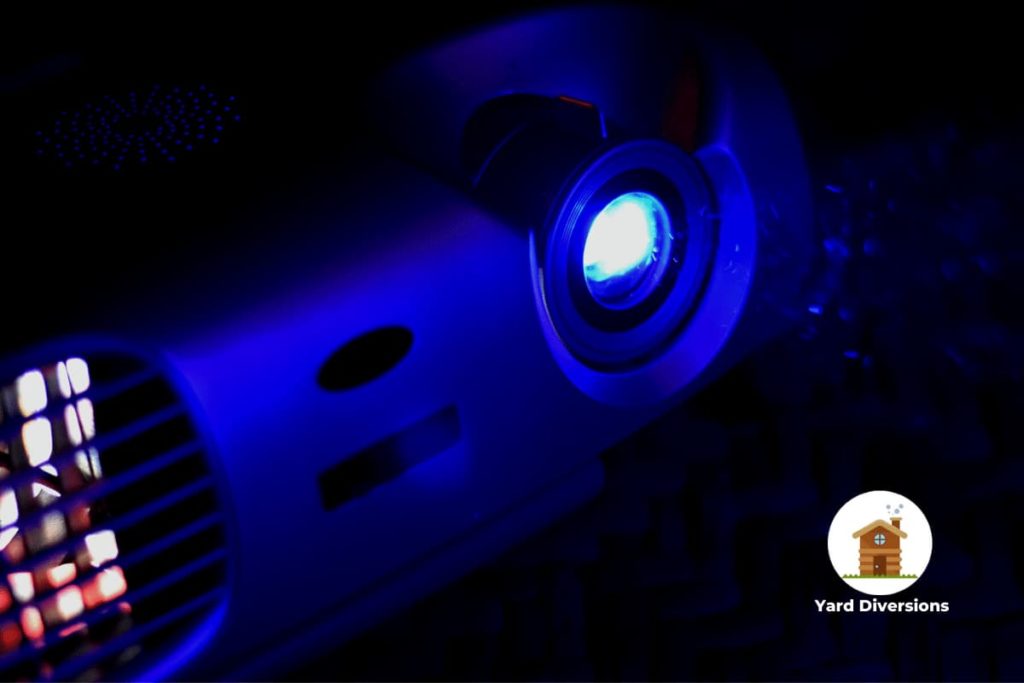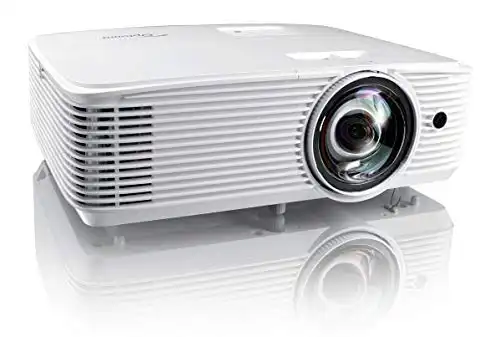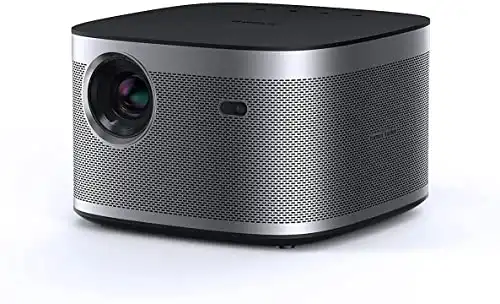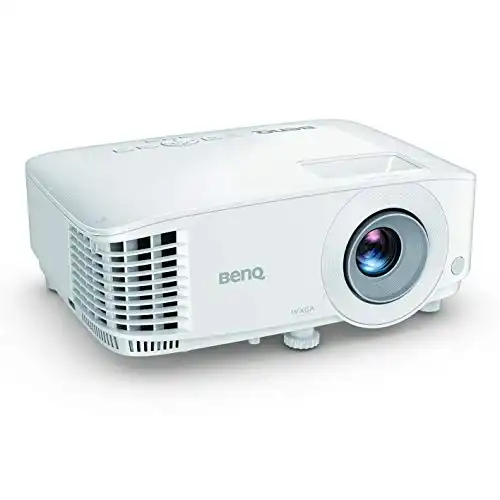For enjoying a movie night with your loved one, or partying with friends on the beach; an outdoor projector is an irreplaceable gadget there’s nothing like it, so let’s dive headlong into our outdoor projector buying guide.
Outdoor and indoor projectors do not have to work in the same environment so although they function the same way, their attributes matter to various degrees.
Buying an outdoor projector for the first time is not a simple job. There are so many factors that come into play like throw distance, contrast, brightness, resolution, etc.
You might think that these factors also matter when buying projectors indoors; but in reality, they don’t matter as much as they do for outdoor projectors.
In this article, I will guide you through the things you should consider when buying an outdoor projector.
There will also be a separate discussion about projector screens because that becomes a headache for many first-time projector buyers.
So, without any further ado, let’s jump right in on this outdoor projector buying guide.

About Projector Screens
There is often a dilemma about projector screens. You can project your favorite movie on your garage wall so why invest in a separate screen?
Any plain surface can work as a projector screen. You can also make projector screens at home. With so many options, many become confused.
For the best image quality, you should invest in a separate projector screen.
The most important attribute of a projector screen is gain. It’s the measurement of how wide the screen reflects the light from the projector.
A 1.0 gain means that the light will reflect equally over a 180-degree angle.
More gain means less the angle which means you can see more vividly directly from the front and the image dims outside of the angle. Also, there is a resolution factor.
Projectors screens are specifically designed for 720p, 1080p, 4K, etc. resolutions. The same goes for aspect ratio.
Mismatching the aspect ratio of the projector and the screen can result in letterbox and pillar-box effects.
To mitigate all these possible mishaps, buying a separate projector screen is a wise decision.
Outdoor Projector Types
Outdoor projectors are categorized based on their projection type.
The liquid crystal display (LCD), the light-emitting diode (LED), and the digital light projection (DLP) are the three primary types of projection that outdoor projectors utilize.
LCD Projectors
The liquid crystal display (LCD) technology has become the industry standard for low-end projectors.
These projectors are typically brighter, more affordable, and more silent than those that use LED or DLP.
LCD projectors typically have lower contrast ratios, which can result in images that appear more washed out when projected.
However, whether paired with the appropriate projector screen, they have the potential to be a reliable option for outdoor theaters.
LED Projectors
LED projectors, also known as light-emitting diode projectors, aren’t quite as powerful as LCD projectors, but they are far more portable, quieter, and efficient with their use of electricity.
LED projectors use bulbs that last the longest and are the most portable, and they may frequently outperform DLP projectors in terms of brightness and resolution.
LED projectors are becoming increasingly popular.
DLP projectors
Lasers are used in digital light projection (DLP), which is also referred to as “laser” projection. The remainder of the technology is the same.
The vast majority of movie theaters in operation today make use of DLP projectors. DLP projectors deliver smooth video and good contrast, but they are physically larger than LCD and LED projectors.
The use of digital light processing (DLP) is prevalent in indoor home theaters, which are designed by dedicated film fans in an attempt to recreate the viewing experience of going to the movies.
How To Choose An Outdoor Projector?
Lots of factors come into play when buying outdoor projectors. There are lots of things that you have known and understood.
Here are the things that you should consider when buying an outdoor projector:
Throw Distance and Size
Throw distance is a new term that you will encounter when buying a projector. You won’t find it anywhere else like television, monitor, etc. Throw distance is the distance between the projector and the screen.
There are short throw and long throw projectors. Short throw projectors are those that you can place close to the screen and enjoy a big enough image.
Long-throw projectors are those that need to be placed further than short-throw projectors to have an image that fits the screen.
You can already understand that short-throw projectors are suitable for smaller places and long-throw projectors work best for big, spread-out places.
The size of the screen depends on throw distance and the projector resolution.
The more distance between the projector and the screen, the bigger the image but at the same time, the image can become blurry.
That’s where resolution comes into play which I will discuss later.
Brightness
When using indoor projectors, we turn off the lights to have a brighter image. So, brightness isn’t much of an issue for indoor projectors.
For outdoor projectors, brightness is a great issue because of the ambient lighting.
You can’t turn off the light if you want to. The day can be too bright or moderately bright depending on the weather.
There can also be other artificial light sources like the headlight of cars, street lights, etc. To make sure that your projector can display the image at a brightness that can outshine all that ambient lighting, you need to choose brightness carefully.
ANSI (American National Standards Institute) unit is used for measuring brightness in projectors. You don’t have to go into every detail.
Just knowing that projectors with 2000 to 3000 ANSI lumen rating are good enough to produce a clear image in most weather. Areas with more ambient lights require 3000 ANSI lumens.
Contrast ratio
The contrast ratio is the brightness difference between the darkest spot and the brightest spot of an image. You will see it very often when buying projectors.
Although it is a bit technical, as a consumer, just knowing that a high contrast ratio means better image quality is enough.
The contrast ratio is stated as 2000:1 or 3000:1 which means that the brightest pixel of an image is 2000 or 3000 times brighter than the darkest pixel of an image, and the projector can display that contrast difference.
For outdoor projectors, a high contrast ratio is a must because of all the ambient lights you will face. Go for at least a 10000:1 aspect ratio projector.
High contrast ratio projectors are also pricier so you have to balance your budget and projector quality.
Aspect Ratio
When buying an outdoor projector, you will see various aspect ratios like 4:3, 16:9, 16:10, etc. It might confuse you about which ratio you should choose.
But if you are someone who watches movies or plays video games regularly, you will know that 16:9 is the standard aspect ratio.
All modern movies, TV series, and video games support the 16:9 aspect ratio and it also looks the best.
However, if the aspect ratio of your projector and the image don’t match, some portions of the image will be cropped when displaying.
This is known as the letterbox or pillar box effect.
Resolution
Resolution determines the quality of the image. High resolution means a crisp image, lower resolution means a blurry image. Of course, that also depends on the screen size.
You can have as high as 4k resolution if you want, but that won’t suit most consumers’ budgets. Striking a balance between budget and demand is the key here.
1080p is the standard resolution that should match your budget. But it also depends on the size of the area and the throw distance.
If the area is big, you will need a long throw projector. In that case, the resolution will also need to be higher to maintain the image quality.
On the other hand, you can opt for a short-throw projector if the area is smaller. You can even go for a 720p projector if the area is small enough.
If things seem too confusing for you, just settle for a 1080p projector; this should do in most cases.
Bulb Life
A projector projects light on the screen which we see as the image. There are bulbs in the projector that produce the light. The bulb has a specific lifespan which starts from a few thousand hours.
You will see bulb life advertised as 40000 or 50000 hours. Higher bulb life is better but at the same time, you shouldn’t be much concerned about it.
50000 hours is equal to almost 6 years. Even if you run your projector for 10 hours daily, the bulb will last for 13 years. You are most likely to switch to an advanced projector by that time.
Even if the bulb doesn’t last that long, you can replace it for about $50. If it’s within the warranty period, the manufacturers shall replace that for free.
So the bottom line is that go for a projector with a higher bulb lifespan but don’t worry too much about it.
Connectivity
You may need to connect your projector with a lot of different devices so outdoor projectors come with plenty of options.
However, it’s always good to check the input and output ports of the projector you are buying.
Indoor projectors usually have a VGA port, HDMI port, display port, USB port, and power port. These are the standard ports of a projector.
As you are more likely to use a mobile, tablet, laptop, or maybe a pen drive with an outdoor projector, such projectors have more connectivity options.
Cables are more important than various connectivity ports. You will need various converting cables like USB-C to HDMI, USB-C to display port, etc. most of the time.
So, make sure that you are getting the cables to use the built-in ports of the projector.
Wireless
Projectors weren’t much of a wireless thing in the past but recently, just like every electronic device; projectors have gone smart with Wi-Fi connectivity.
This means that you can connect your devices wirelessly to the projector without needing any cable. It drastically reduces the need for various wires and staff.
Also, you can browse the internet and project videos directly from the internet on the screen. You can browse various OTT platforms like Netflix, Disney plus, etc., and stream your favorite show from the internet directly onto the screen.
It eliminates the need for any type of cable or device. The only downside is that you won’t get wireless internet everywhere.
You can avail yourself of it most in areas near your house but when you are out in the woods, you are not likely to get strong internet access to use the Wi-Fi feature.
Sound
All the projectors, indoor and outdoor come with built-in speakers. Not only projectors, but any type of display device like television, monitor, etc. also come with built-in speakers. So technically, you won’t need any separate audio output device to use your projector.
But it’s all in theory. The built-in speakers in projectors are really small which means the audio quality is poor and typically not ideal for playback, especially over patio size areas.
If you increase the volume level, the audio will be distorted. So having or not having built-in speakers doesn’t matter much practically.
If you want impeccable audio performance, my suggestion is to get a good quality sound system that both suits your budget as well as delivers crisp quality audio. Audio systems don’t cost much nowadays.
My suggestion is to get a high-quality soundbar, like this Bose Smart Soundbar 900 Dolby Atmos, instead of stereo speakers as they are easy to carry and produce excellent quality audio.
Brand
Many users don’t care which brand they are getting. They think brands are a gimmick for ripping off naïve customers and opt for lesser-known brands.
However, brand value is a thing for a reason. Big brands make better quality products and also give much better after-sales service.
Spare parts are easily available for renowned brands and repairing is also cheap. One thing big brands need to maintain that cheap ones don’t is their reputation.
Popular brands have come a long way so they try their heart and soul to maintain their reputation among the customers.
Smaller new brands often disregard their customers after selling a product and you can be that victim.
So regardless of your budget or what type of outdoor projector you want to buy, always go for a well-known brand.
Choosing The Optimal Power Source For Your Projector
Outdoor projectors are portable so they run on batteries. But you should use AC power for all of your gadgets like the projector, audio system, etc.
Even though projectors can run on batteries, their performance diminishes when using batteries.
Some projectors struggle to project images at optimal brightness even on AC power so you can easily understand that relying on battery power won’t be wise.
Also, depending on batteries means that you need to check if the batteries are fully charged.
You also need to carry separate batteries, battery chargers, etc. before going on a trip. A professionally installed AC power outlet can save you from all the hassles.
Make sure that you install the outlet near the devices so that you don’t have to use long extension cords.
You might trip over them and break a tooth or two. Also, be sure that any outlet you are using is properly grounded to prevent any electrical hazards.
Can Ground-Mounted Solar Panels Power an Outdoor Projector?
Ground-mounted backyard solar panel installation can indeed power an outdoor projector. By harnessing the energy from the sun, these panels generate electricity that can be used to power a wide range of devices, including projectors. This convenient power source eliminates the need for traditional electricity, making outdoor projections eco-friendly and cost-effective.
How Much Should You Spend On An Outdoor Projector?
A good projector doesn’t have to set you back hundreds of dollars. While portable projectors tend to be about 720p, some of the cheaper projectors now boast 1920 x 1080 native resolutions.
As an entry point, I believe that spending between $500 and $600 will provide you with good specs.
There are several factors to consider when deciding how much money to invest in new technology.
There is a lot to like about 4K projectors, but they are also extremely pricey. Cheaper projectors might make you lucrative offers but stay clear of them.
You might save some money but in exchange for picture quality, poor noise reduction, insufficient connectivity, and of course, shorter lifespan paired with bad after-sales service.
These may be advertised for under $100. Outdoor projectors have to do a lot of things and cheaper ones can’t carry the weight.
Can I Use an Outdoor Projector on My Patio Without Impacting Property Taxes?
Yes, you can use an outdoor projector on your patio without impacting your property taxes. According to patios and property taxes information, adding amenities like a projector doesn’t typically affect your property taxes unless it increases the overall value of your home. Always check with your local tax authority for specific regulations.
Conclusion
Many people become surprised by how many factors you need to check before buying an outdoor projector.
It is mostly because you cannot control the outside environment so your projector will have to compensate for everything nature throws at you.
Making mistakes is easy when you don’t know what you are buying. A straightforward outdoor projector buying guide can be the savior for first-time buyers.
I believe I could touch on all the crucial topics that you should know as a first-time buyer of the outdoor projector; I expect buying your first outdoor projector will go as effortlessly as it can get. Have a great day!




